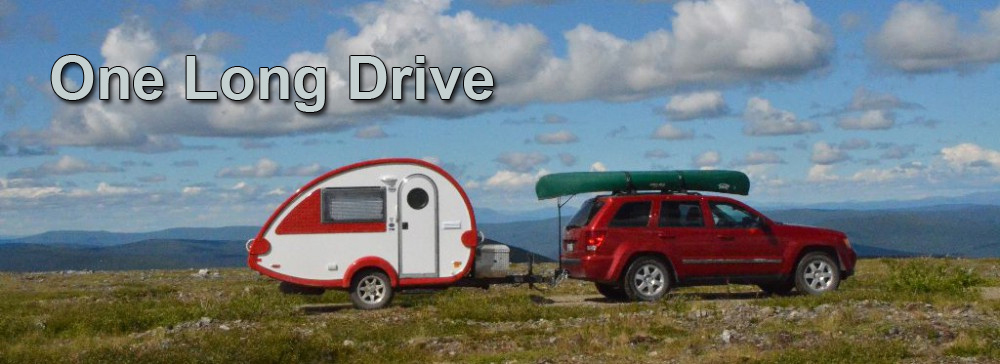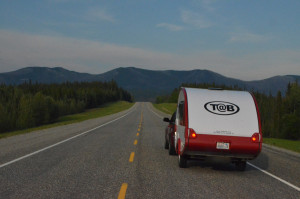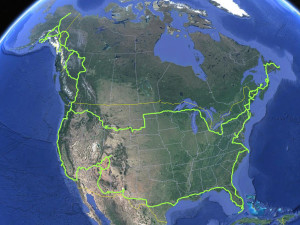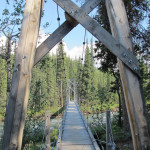July 10, 2015 – Denali National Park – Alpine Tundra Wilderness Tour by bus. Beautiful rugged wilderness, not flat like the Arctic Tundra, so pretty well drained although the ground is frozen. We spotted Moose, Caribou, Dall Sheep, and a far off Grizzly Bear. Great day, you could do this tour over and again and it would never be the same.
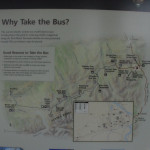 Only concession buses are allowed on the 90 odd mile long Park Road. Taking a tour on one of these buses is a great way to experience the park’s scenery and wildlife. A sign about the bus transportation in the park explains that the buses have been in operation since 1972, personal vehicles are generally not allowed beyond mile 15. Reasons mentioned to use the bus include
Only concession buses are allowed on the 90 odd mile long Park Road. Taking a tour on one of these buses is a great way to experience the park’s scenery and wildlife. A sign about the bus transportation in the park explains that the buses have been in operation since 1972, personal vehicles are generally not allowed beyond mile 15. Reasons mentioned to use the bus include
- Riding high on bus seats in the company of many watchful passengers increases your chances of seeing wildlife.
- Knowledgeable bus drivers enhance your Park Road experience.
- Reduced traffic allows wildlife to travel more freely along the road corridor.
- The buses minimize air emissions by using low-sulfur fuel and particular traps.
I wholeheartedly agree with these. Many of our wildlife sightings were indeed spotted first by a passenger, and the bus driver was quite a resource. There were plenty of buses and I can’t imagine what sort of crazy experience it would have been if these were replaced with all private vehicles. The rangers also explained that because people on the bus were under supervision, and kept from interacting with the wildlife, they pretty much disregard vehicles and wander more closely to visitors without concern.
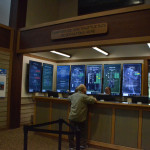 I booked my tour the day before, the tours were all pretty full but being just one person made it a little easier to find a spot. My tour was in the afternoon, and I chose the Tundra Wilderness Tour. This is a 7-8 hour tour that goes as far as the Toklat River Rest Stop at mile 53 and back.
I booked my tour the day before, the tours were all pretty full but being just one person made it a little easier to find a spot. My tour was in the afternoon, and I chose the Tundra Wilderness Tour. This is a 7-8 hour tour that goes as far as the Toklat River Rest Stop at mile 53 and back.
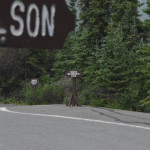 After I had lunch at the Morino Grill, I headed over to the Wilderness Access Center to pick up my bus. I was a little early and scoped things out. On one side of the building is parking, and on the other is a large circular drive where buses load and unload. There are signs along the drive indicating which bus stops where. As I was milling about I noticed a group of young men milling about, and came to recognize it as a scout troop. I chatted with the leader, and it turns out they were going to be on the same bus with me. I chatted with their senior patrol leader for a few minutes and asked him a few questions about how his troop was doing. He had some good insights about the balance of things and his vision for the troop. I complimented him on his insight and offered some thoughts from my own experience that reinforced his thinking.
After I had lunch at the Morino Grill, I headed over to the Wilderness Access Center to pick up my bus. I was a little early and scoped things out. On one side of the building is parking, and on the other is a large circular drive where buses load and unload. There are signs along the drive indicating which bus stops where. As I was milling about I noticed a group of young men milling about, and came to recognize it as a scout troop. I chatted with the leader, and it turns out they were going to be on the same bus with me. I chatted with their senior patrol leader for a few minutes and asked him a few questions about how his troop was doing. He had some good insights about the balance of things and his vision for the troop. I complimented him on his insight and offered some thoughts from my own experience that reinforced his thinking.
A larger family decided to queue up at the sign for our tour about 45 minutes prior to the scheduled arrival time. Given the size of their group I’m sure this was so that they could sit together. I was thinking I’d like to sit in the back row, so I decided to make myself the second party in line, and figured 45 minutes wasn’t too bad to stand around for a choice at seats. The sun wasn’t blazing down on us today, it had been a nice morning, but more clouds today. A few very light showers passed over while we waited.
Our departure time came and passed. About 20 minutes after the departure time a staff member came out and walked around and headed back in, but she didn’t have any answers about what was going on. A few people were getting upset, but I was speculating that the bus had been held up by the crazy construction traffic on the main highway. The bus’s first stop was at a lodge that was deep in the heart of the construction, so it made sense that they might have trouble getting on the road. I did what I could to suggest this theory to people who were getting upset at the delay. Several buses arrived for other destinations, and came to drop off folks as well. But our bus was still not here.
I believe it was about an hour after departure time when a staff member came out and said they had heard from the driver and that he had indeed been stuck waiting to merge into the stopped construction traffic and had just gotten on the highway. So when the bus finally arrive we got started, about 90 minutes late. In the end it was no worry, great tour.
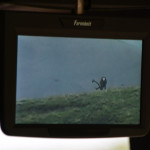 The first 14 miles of the Park Road are open to private vehicles, but it was still primarily buses that we saw. As we met buses coming the other way the drivers had hand signals they would use to indicate if they had seen something ahead. Our driver stopped and talked with a couple of bus drivers and eventually he announced that he had found what he was looking for. The buses have overhead drop down screens on which you might play a video or some such. With the number of buses going out today and us being later he didn’t get a video camera, so he was looking to get one from a returning bus. The digital video camera has a pretty high power lens, and the driver can use it to display a close up view of distant wildlife for those who don’t have binoculars, or aren’t currently able to see out the window. As it turns out this was a really nice idea.
The first 14 miles of the Park Road are open to private vehicles, but it was still primarily buses that we saw. As we met buses coming the other way the drivers had hand signals they would use to indicate if they had seen something ahead. Our driver stopped and talked with a couple of bus drivers and eventually he announced that he had found what he was looking for. The buses have overhead drop down screens on which you might play a video or some such. With the number of buses going out today and us being later he didn’t get a video camera, so he was looking to get one from a returning bus. The digital video camera has a pretty high power lens, and the driver can use it to display a close up view of distant wildlife for those who don’t have binoculars, or aren’t currently able to see out the window. As it turns out this was a really nice idea.
Generally speaking the encounters with wildlife on this type of tour are well suited for adults and older children. An 8 hour ride confined to a single seat in a bus, briefly interrupted with short stops to strain and try to see wildlife through binoculars before the animals move on is not quite as exciting as a two or three year old might hope for. A younger child may not appreciate the difference in seeing animals in the wild going about their own business, versus seeing them in a zoo or museum. And they may be frustrated by seeing them at a longer distance versus close up or even where they can be touched. Consequently many of the families on the tour had their hands full keeping their kids entertained. Some were having a lot more success than others.
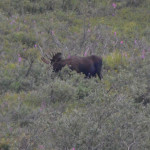 In the bushy lowland areas we saw Moose grazing, often a solo female, but at least one male with a impressively large rack of antlers. When we came closer to steep slopes it was pretty easy to pick out the white Dall Sheep as they stand out quite clearly. Protection of the Dall Sheep was a primary reason for the creation this park, and the reason that the sheep is a primary part of the park’s logo.
In the bushy lowland areas we saw Moose grazing, often a solo female, but at least one male with a impressively large rack of antlers. When we came closer to steep slopes it was pretty easy to pick out the white Dall Sheep as they stand out quite clearly. Protection of the Dall Sheep was a primary reason for the creation this park, and the reason that the sheep is a primary part of the park’s logo.
As we got into the open alpine tundra areas we saw more caribou, a couple of solo males gave a good opportunity for the driver to use the video camera to give everyone a good view. When someone spotted an animal the driver would stop to get an idea where it was, then position the bus for best viewing. Then everyone on the viewing side would lower the upper half of the bus windows, often with the help of other passengers as the windows required some dexterity to operate. Next we would take turns pointing cameras and binoculars out the windows, hopefully keeping the noise down. Staying in the bus means less impact on the animals’ behavior, and it also means we can stop more often since unloading and loading the bus takes a surprising amount of time. I might add that some folks were very good at sharing access to the windows, and some were not as aware. I shared my binoculars around a bit.
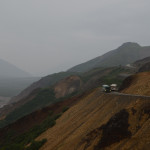 When the buses passed each other the agreement was that the bus with the drop off on the left would find a wide spot and pull off to the right as far as practical and stop. The other bus would then navigate around the stopped bus and pass. This worked out quite well.
When the buses passed each other the agreement was that the bus with the drop off on the left would find a wide spot and pull off to the right as far as practical and stop. The other bus would then navigate around the stopped bus and pass. This worked out quite well.
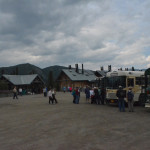 About halfway along the route there is a large rest area where the bus stops. There is a large decked overlook of the river here, and several buildings with individual pit toilets. It was a good opportunity to stretch out and get some fresh air. As we had moved into the mountains the weather had become wetter, and the gravel parking lot was wet with a few shallow puddles. The bus windows collected spatter from the road, so the bus driver enlisted a few folks to help wash down the windows with equipment and water he had on board. The restrooms were nicely built, with a bit of architectural flair. The doors were heavy wood with a sliding wood bar and robust metal fittings all of which suggested rustic construction. A nice touch on the doors was a simple occupancy indicator that was nothing more than a large circular hole that was backed by the sliding bar. When the bar was slid away the hole showed green and when in the “locked” position bar had a red area that showed through.
About halfway along the route there is a large rest area where the bus stops. There is a large decked overlook of the river here, and several buildings with individual pit toilets. It was a good opportunity to stretch out and get some fresh air. As we had moved into the mountains the weather had become wetter, and the gravel parking lot was wet with a few shallow puddles. The bus windows collected spatter from the road, so the bus driver enlisted a few folks to help wash down the windows with equipment and water he had on board. The restrooms were nicely built, with a bit of architectural flair. The doors were heavy wood with a sliding wood bar and robust metal fittings all of which suggested rustic construction. A nice touch on the doors was a simple occupancy indicator that was nothing more than a large circular hole that was backed by the sliding bar. When the bar was slid away the hole showed green and when in the “locked” position bar had a red area that showed through.
The rest area didn’t have running water but there was drinking water in aluminum bottles on the bus. Aluminum is easily recyclable, is light but doesn’t break, so it works out nicely for the park. Snack boxes had been laid out on the seats when we boarded the bus, and this was a good time to dip into mine. It wasn’t a long stop, and after a head count we were back on the road.
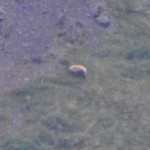 From the cues provided by oncoming buses we spotted a grizzly bear well up on a mountainside. Mostly a little spot even under visual magnification, but it was a very blonde bear by comparison to any others I saw on the trip. The road winds along the hillsides dropping down to cross the wide rivers full of glacial runoff. The lack of trees made for sweeping views out the windows. Often the downhill side of the road was a steep drop off, and the uphill side a steep mountainside. Once or twice I saw a sheep momentarily visible on the cliff above, not something everyone on the bus could have seen. I also spotted several smaller animals like rabbits and a skunk, and several birds this way.
From the cues provided by oncoming buses we spotted a grizzly bear well up on a mountainside. Mostly a little spot even under visual magnification, but it was a very blonde bear by comparison to any others I saw on the trip. The road winds along the hillsides dropping down to cross the wide rivers full of glacial runoff. The lack of trees made for sweeping views out the windows. Often the downhill side of the road was a steep drop off, and the uphill side a steep mountainside. Once or twice I saw a sheep momentarily visible on the cliff above, not something everyone on the bus could have seen. I also spotted several smaller animals like rabbits and a skunk, and several birds this way.
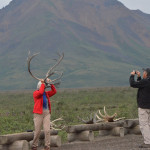 The bus stopped again at our turn around point Toklat River. There is a sort of temporary building here with a bookstore inside. The bus driver’s warned that our stop was pretty short, and be careful not to fall into the “black hole” as the bus drivers had named it. I went inside and did a once around. Nothing here that I had an immediate need for, and most seemed like things that would be at the main store by the visitor’s center also. Out on some benches there were several antlers laid out where you could touch and pick them up. Surprisingly heavy, I can’t imagine wearing these on your head, it certainly would change things. Lots of folks doing a photo with the antlers and having a lot of fun with that.
The bus stopped again at our turn around point Toklat River. There is a sort of temporary building here with a bookstore inside. The bus driver’s warned that our stop was pretty short, and be careful not to fall into the “black hole” as the bus drivers had named it. I went inside and did a once around. Nothing here that I had an immediate need for, and most seemed like things that would be at the main store by the visitor’s center also. Out on some benches there were several antlers laid out where you could touch and pick them up. Surprisingly heavy, I can’t imagine wearing these on your head, it certainly would change things. Lots of folks doing a photo with the antlers and having a lot of fun with that.
 We had enough extra time to head up a little further along the road, which is something they typically only do if the weather provides a view of Denali, which wasn’t happening today. But the driver offered to let folks hop off and do a quick walk around the tundra as we drove further along and then came back that way fifteen minutes later. It was a hard choice on whether to stay on or go walk on the tundra. But I decided to stay on board. Those of us who stayed on were rewarded with a close encounter with a small group of female caribou who crossed the road in front of the bus and wandered up on the hill just above us, offering a perfect photo opportunity.
We had enough extra time to head up a little further along the road, which is something they typically only do if the weather provides a view of Denali, which wasn’t happening today. But the driver offered to let folks hop off and do a quick walk around the tundra as we drove further along and then came back that way fifteen minutes later. It was a hard choice on whether to stay on or go walk on the tundra. But I decided to stay on board. Those of us who stayed on were rewarded with a close encounter with a small group of female caribou who crossed the road in front of the bus and wandered up on the hill just above us, offering a perfect photo opportunity.
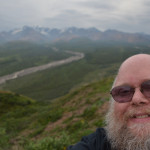 On the road back we stopped at Polychrome Pass for a quick look around. The many colors of rocks in the hillside complimented the colors of low growing bushes, moss and lichens. The area had been pretty crowded with other buses on our way in, and the bus driver’s choice to come here later was rewarded with the clouds raising up a little and the rain holding off. I climbed up the stairs to a short path above the road, took some photos and enjoyed the wide views, but it was a short stop, and so back to the bus. Near the end of the trip we got a quick glimpse of a wolf on the road. Try as we may, we weren’t able to find him again.
On the road back we stopped at Polychrome Pass for a quick look around. The many colors of rocks in the hillside complimented the colors of low growing bushes, moss and lichens. The area had been pretty crowded with other buses on our way in, and the bus driver’s choice to come here later was rewarded with the clouds raising up a little and the rain holding off. I climbed up the stairs to a short path above the road, took some photos and enjoyed the wide views, but it was a short stop, and so back to the bus. Near the end of the trip we got a quick glimpse of a wolf on the road. Try as we may, we weren’t able to find him again.
Things to do in Denali on the list for another time would include visiting the sled dog kennels, taking the bus out into the tundra for a day or overnight hike, and visiting the other visitor centers. I’d say that no matter how many times you take the bus tour it would be different and interesting.
